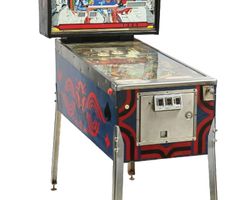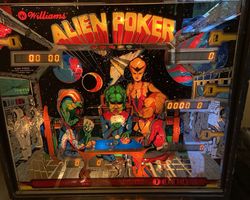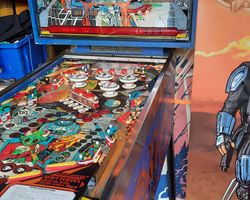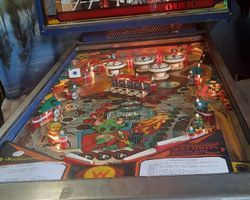Alien Poker

Average Prices: USD $200 to $1,100
Produced: October, 1980
Production Run: 6,000 units
Machine Type: Solid State Electronic
MPU: Williams System 6A
Players: 4
Design by: Edward Tomaszewski
Art by: Tony Ramunni
Sound by: Paul Dussault
Software by: Paul Dussault
Williams Electronic Games, Inc. released Alien Poker in October 1980, adding a unique blend of sci-fi aesthetics and classic card game themes to its solid-state pinball lineup. This machine emerged from an era where Williams was solidifying its reputation for creating engaging and technologically progressive games. Production totaled 6,000 units, a respectable run for the time, indicating its initial market acceptance.
The creative minds behind Alien Poker wove together a distinct vision. Edward Tomaszewski, the designer, crafted the playfield layout, envisioning the intricate shot paths and objectives. Tony Ramunni, the artist, was responsible for bringing the "aliens playing poker" concept to life through the machine's distinct visual presentation. Paul Dussault handled the software programming and speech processing, imbuing the game with its characteristic robotic alien voices, while Eugene Jarvis developed the soundscape, contributing to the overall immersive experience. Alien Poker operates on the Williams System 6A MPU, an iteration of the System 6 board distinguished by its seven-digit score displays. An interesting facet of its development involved an initial design for a multi-ball mode, a feature ultimately omitted from the production model, though a kit was later made available to add it. Prototype versions of the game featured contoured playfield plastics and yellow kick-out holes, differing slightly from the production units, which also added the game's title and copyright information near the drop target inserts. Promotional playing cards, marked as made in the U.S.A., were also distributed, further tying into the game's card-centric theme.
Signature Features and Design
Alien Poker is immediately recognizable for its distinctive blend of science fiction and traditional casino themes, a concept that underpins its entire design. Tony Ramunni’s artwork, particularly on the backglass, has consistently generated discussion within the pinball community. While some find it eccentric or "80s cheese," its unapologetically retro style contributes significantly to the machine's unique identity. The playfield art similarly embraces this theme, featuring stylized aliens engaged in a high-stakes poker game, visually integrating the card suit symbols and alien characters into the environment.
Beyond the visuals, the machine’s auditory experience is a standout characteristic. Eugene Jarvis's sound design, with its electronic sound effects, is reflective of Williams' output from the early 1980s, evoking a strong sense of the era. Complementing these sounds are the custom speech callouts, featuring robotic alien voices processed by Paul Dussault. These callouts are humorous and integral to the game’s charm, announcing objectives and adding personality to the alien characters depicted in the art. Mechanically, Alien Poker distinguishes itself with a three-flipper layout, providing players with additional shot opportunities and strategic depth compared to machines with fewer flippers. The inclusion of a spinner target also offers a satisfying physical interaction point, while a kickback mechanism provides a crucial ball save feature, keeping the action flowing.
Playfield and Mechanics
Edward Tomaszewski’s playfield design for Alien Poker emphasizes precision and strategic shot-making. The layout is dominated by a crucial bank of five drop targets arranged in a vertical line, representing the poker hand. These targets are central to the game's primary objective: achieving a "Royal Flush." This demanding task requires players to hit the targets in a specific, sequential order; failing to do so results in all targets resetting, demanding renewed focus and accuracy. This mechanic forms the strategic backbone of the game, creating a constant tension between risk and reward.
Around these central targets, the playfield features four pop bumpers that contribute to chaotic yet score-building ball movement in the upper sections. There are three kick-out holes strategically placed on the playfield. One serves as an entry to the Royal Flush target bank, while others provide varied shot returns, often feeding the flippers or returning the ball to the general playfield. A single spinning target provides a satisfying tactile and auditory experience when hit, accumulating points as it spins. The playfield lighting, integrated with the artwork, serves to highlight active targets and modes, such as the "Joker Hunt," where specific joker targets flash to indicate scoring opportunities. While the art itself can be polarizing, its bold, colorful representation of the sci-fi poker theme is consistent across the playfield, framing the mechanical elements within its distinctive aesthetic. The overall flow of the playfield encourages deliberate shots, rewarding players who master the angles required to clear the sequential drop targets and activate the various scoring features.
Gameplay Dynamics
The core of Alien Poker's gameplay revolves around the pursuit of the "Royal Flush." This multi-stage objective is tied to the five-bank drop targets, which must be struck in a specific sequence. Successfully completing this sequence not only awards significant points but also increases the game's scoring potential through multipliers. The strategic depth arises from the constant decision of whether to risk resetting the target bank by attempting a difficult shot for a Royal Flush, or to play safer, building points through other targets and objectives. This risk/reward dynamic ensures each game presents compelling choices.
Another notable gameplay mechanic is the "Joker Hunt" mode. This mode activates upon completing all the scattered joker targets on the playfield. Once initiated, specific joker targets begin to flash, moving around the playfield, and hitting them awards substantial points. This adds a dynamic, time-sensitive element to the gameplay, encouraging players to quickly identify and target the illuminated jokers. Alien Poker largely relies on a single-ball experience, a deliberate design choice that distinguishes it from machines focused on multi-ball chaos. This focus on a single ball elevates the importance of precision, control, and strategic planning, making every shot count. Players develop strategies around maximizing their Royal Flush values, utilizing lane changes to set up shots, and expertly navigating the kick-out holes and spinners. This emphasis on skill-based play and the depth of its rule set contribute to its high replayability, often leading players to attempt "just one more game" to perfect their strategy or achieve a higher score. The scoring system, which rewards both precise target completion and strategic accumulation of points, makes Alien Poker particularly well-suited for competitive multiplayer play, fostering engaging contests as players vie for top scores.
Reception and Legacy
Alien Poker has cultivated a notable reputation within the pinball community, often perceived as a well-designed and highly enjoyable solid-state machine from the early 1980s, despite sometimes being overlooked. Its strengths are frequently highlighted in discussions, particularly its gameplay and ruleset. The game's emphasis on target accuracy and the challenging, sequential Royal Flush objective are consistently praised for demanding precise aim and strategic thinking. Players appreciate the risk/reward decisions inherent in the rules, as well as the engaging "Joker Hunt" mode, which provides a dynamic scoring opportunity. Many commend the game's single-ball focus, finding it a refreshing counterpoint to multi-ball-centric designs, fostering a deeper appreciation for fundamental pinball skills. This precision-oriented play, combined with its capacity for different paces—from controlled and deliberate to fast and intense—contributes to its enduring appeal and suitability for competitive play.
The sounds and speech of Alien Poker are also a consistent source of acclaim. The characteristic electronic sound effects and robotic alien voices, often compared to the sounds of classic arcade titles, are widely regarded as immersive and integral to the machine’s distinct retro atmosphere. While the theme itself—aliens playing poker—is recognized for its unique, charmingly kitsch quality, the artwork, especially the backglass, remains the most frequently cited point of contention. Described as "ugly" or "odd" by some, while appreciated for its "80s cheese" by others, its divisive nature is undeniable, yet it contributes to the machine's memorable identity.
Despite its polarizing visuals, Alien Poker's influence stems from its demonstration of how a focused ruleset and engaging mechanics can create a compelling experience without relying on complex multi-ball features. It stands as a strong example of Williams' early solid-state capabilities, showcasing their ability to craft games with significant depth and lasting appeal. Its legacy is that of an underrated classic, a testament to the idea that innovative gameplay and a unique theme can transcend visual preferences, securing its place as a distinctive and respected entry in pinball history.
Sponsored Links
 Ebay Listings
Ebay Listings
 Auction Results
Auction Results
| Cost | Location | Date |
|---|---|---|
| USD $650 |  Nevada, United States Nevada, United States |
01 May, 2025 |
| GBP £1,288 |  Belbroughton, United Kingdom Belbroughton, United Kingdom |
16 March, 2025 |
| USD $2,989 |  Florida, United States Florida, United States |
14 November, 2024 |
| USD $4,200 |  Michigan, United States Michigan, United States |
31 May, 2024 |
| EUR €1,726 |  Nordrhein-Westfalen, Germany Nordrhein-Westfalen, Germany |
02 April, 2023 |
| USD $2,100 |  Illinois, United States Illinois, United States |
12 February, 2023 |
| USD $1,125 |  Pennsylvania, United States Pennsylvania, United States |
11 December, 2022 |
| EUR €1,867 |  Nordrhein-Westfalen, Germany Nordrhein-Westfalen, Germany |
04 December, 2022 |
| USD $1,025 |  Pennsylvania, United States Pennsylvania, United States |
20 November, 2022 |
| USD $890 |  Minnesota, United States Minnesota, United States |
30 October, 2022 |


Private Policy · Search Website · Contact Us
As an eBay Partner, we may earn a commission from qualifying purchases made through links on this site, at no additional cost to you.
All trademarks and copyrighted materials remain property of their respective owners. All other content copyright 2007 - 2025 Pinpedia.







